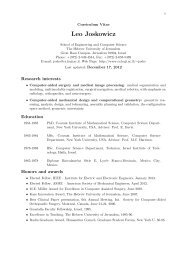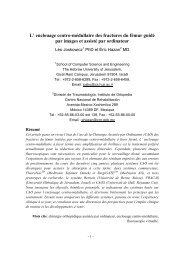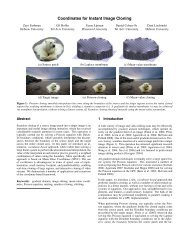TEL AVIV UNIVERSITY Gaddi Blumrosen
TEL AVIV UNIVERSITY Gaddi Blumrosen
TEL AVIV UNIVERSITY Gaddi Blumrosen
Create successful ePaper yourself
Turn your PDF publications into a flip-book with our unique Google optimized e-Paper software.
When only one BF (direction) exists, v , 0,<br />
,<br />
0 and the eigenvector is the estimated<br />
channel, the matrix WT<br />
gets the classical meaning of BF (one dimensional BF), and if<br />
the channel estimate is perfect then U X becomes simply X.<br />
3.2.3 Optimal MMSE BF<br />
<br />
In this chapter an MMSE approach for BF is introduced. In this approach, a different<br />
weight is induced for each antenna, and forms one vector and thus is sometimes<br />
referred to as one dimensional BF. In order to adopt these weight, (antenna weight<br />
vector), to our system model (antenna weight matrix), the antenna weight matrix has<br />
to be diagonal where its terms are the same as the antenna weights.<br />
In the case of receive diversity (SIMO, similar to [3]), the cost function, obtained for<br />
instance, by sending training sequence (pilot), where H is assumed as being perfectly<br />
estimated, is:<br />
H<br />
2<br />
H H H<br />
R R R<br />
J( W) arg min E W Y X E( W Y X ) ( W Y X )<br />
WR<br />
and in the case of transmit diversity (MISO), the cost function is:<br />
T<br />
(3.6)<br />
(3.7)<br />
From considerations of reciprocallity, reasonable in many channel models, the receive<br />
weights will be the same as the transmit weights. Therefore, with out loss of<br />
generality, we will describe here the optimal weight for receive diversity as were<br />
derived in [3]. Following the method in [5], the gradient:<br />
(3.8)<br />
H<br />
H<br />
Where RY E(<br />
YY ) is the received signal autocorrelation and RYX E(<br />
YX ) is the<br />
cross correlation between received and transmitted signals. The solution of (3.8) is the<br />
Spatial Winner filter:<br />
1<br />
WR<br />
RY<br />
RYX<br />
(3.9)<br />
H<br />
With the power normalization E( XX ) INt<br />
By substituting our system model in (2.45), we obtain:<br />
WR E(( HX N)( HX N) ) E(( HX N) X )<br />
(3.10)<br />
1 1<br />
( Rhh RN)<br />
E( H)<br />
In the case EH ( ) is zero, equal antenna weights are used (from symmetric<br />
considerations).<br />
In the simple case of slow fading, the channel tends to be constant in reservation<br />
period (e.g. LOS) and the location of the reception source is the same as the steering<br />
vector in the source direction. (3.9), then becomes [3]:<br />
(3.11)<br />
When the noise is not directional (like our system model), (3.11) becomes:<br />
1<br />
WR<br />
<br />
N<br />
h<br />
(3.12)<br />
1<br />
H<br />
2<br />
H H H<br />
T T T<br />
J( W ) arg min E Y HW X E( Y HW X ) ( Y HW X )<br />
WT<br />
J ( W ) ( E( W Y X ) ( W Y X )) 2 E( YY ) W 2 E( YX )<br />
2R W 2R 0<br />
W<br />
Y R YX<br />
1<br />
RNh R <br />
H 1<br />
N<br />
h R h<br />
R<br />
H H H H H<br />
R R R<br />
H 1<br />
H








